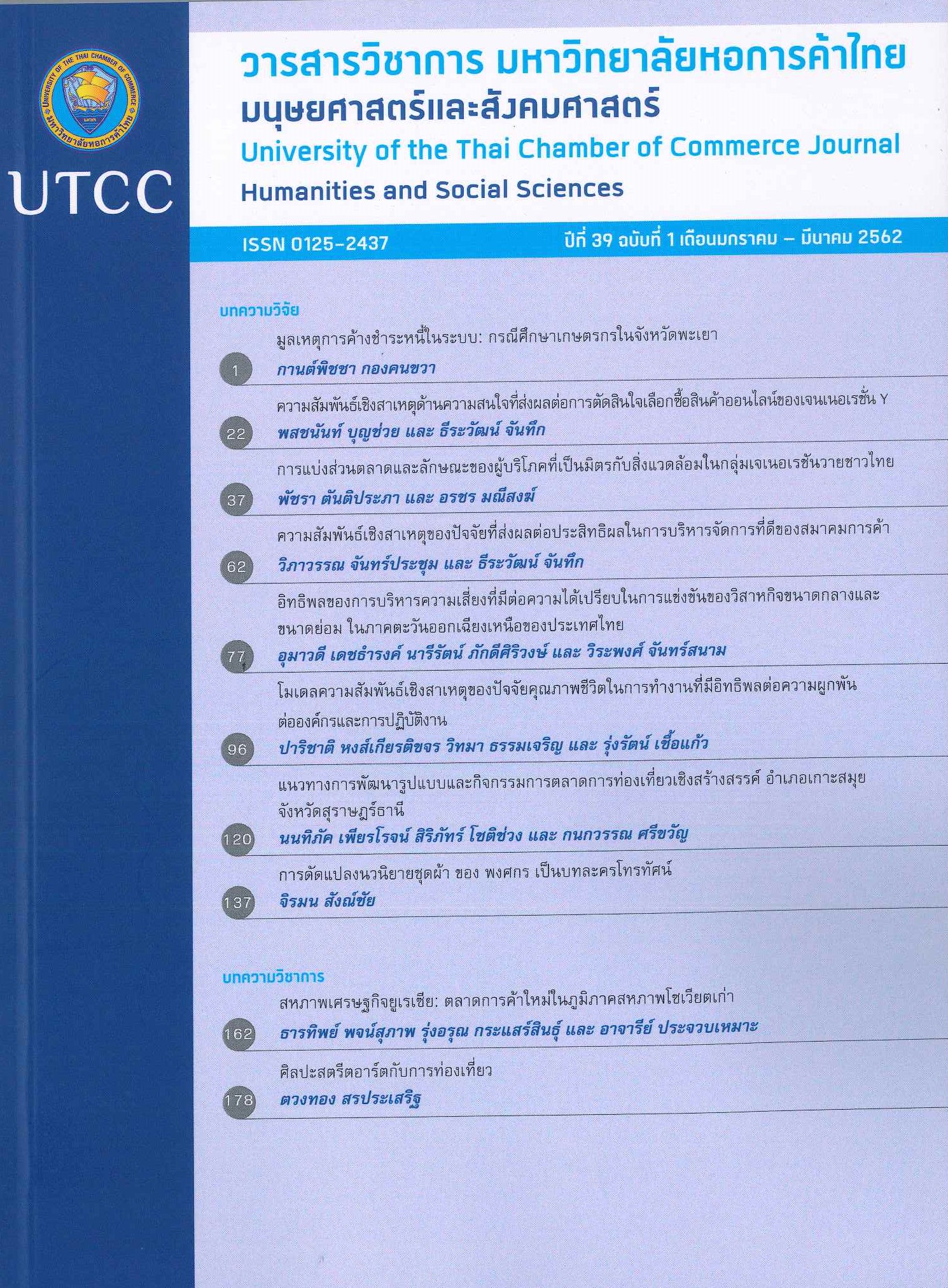Eurasia Economic Union: Emerging Market in the Former Soviet Republic Region
Main Article Content
Abstract
Regional integration has become popular after the end of the World War II. Economic integration is not only ever-closer cooperation of states in a political field. In many cases, it also creates opportunities for international trade and investment by removing tariff barriers and increasing the bargaining power. Eurasia Economic Union or EAEU aims to create a free trade zone in the post-soviet area, establish a common system of external tariffs and other barriers to reduce import of foreign competitors and has protected their domestic industries. The member states of EAEU is a new potential market and potentially the gateway of trade between East Europe and Southeast Asia.
Article Details
ลิขสิทธิ์ของบทความ
ผลงานที่ได้รับการตีพิมพ์ถือเป็นลิขสิทธิ์ของมหาวิทยาลัยหอการค้าไทย ห้ามมิให้นำเนื้อหา ทัศนะ หรือข้อคิดเห็นใด ๆ ของผลงานไปทำซ้ำ ดัดแปลง หรือเผยแพร่ ไม่ว่าทั้งหมดหรือบางส่วนโดยไม่ได้รับอนุญาตเป็นลายลักษณ์อักษรจากมหาวิทยาลัยหอการค้าไทยก่อน
References
Amiti, S. (2016). India’s proposed trade pact with Russia-led EAEU bloc on fast track. RetrievedJanuary 26, 2017, from http://www.thehindubusinessline.com/economy/indias-proposed-
trade-pact-with-russialed-eaeu-bloc-on-fasttrack/article8206297.ece
Aslund, A. (2013). Push for customs union turns friends to foes. Retrieved December 4, 2017,from http://www.themoscowtimes.com/opinion/article/push-for-customs-union-turns-friends- to-foes/485789.html
Deceuninck, F. (2016). The European Union & the Eurasian Economic Union: Competingregionalisms towards the neighbourhood? Ukraine being sandwiched between two blocs
(Unpublished master’s thesis). Université Catholique de Louvain, France.
Dragneva, R., & Wolczuk, K. (2015). Ukraine between the EU and Russia: The integration challenge.London, England: Palgrave Macmillan.
Eurasian Development Bank. (2017). Bank profile. Retrieved July 26, 2017, from https://eabr.org/ en/about/
EurasianEconomic Commission. (2016).Eurasianeconomic integration:Facts andfigures. Retrieved December 4, 2017, from http://www.eurasiancommission.org/en/Documents/БрошюраЦифры и факты итог англ.pdf
Eurasian Fund for Stabilization and Development. (2017). About EFSD. Retrieved December 4, 2017, from https://efsd.eabr.org/en/about/
Fabbrini, S. (2009). European regionalism in comparative perspective: Features and limits of the new medievalis approach to world order. Coral Gables, FL: University of Miami.
Hancock, K. L., & Libman, A. (2014). The forgotten region: Russia and Eurasia. Retrieved December 4, 2017, from http://web.isanet.org/Web/Conferences/FLACSO-ISA%20BuenosAires%202014/Archive/61fcee73-a1f4-4aab-ae78-96164936ee08.pdf
Kazanstsev, A. (2008). Russian policy in Central Asia and the Caspian Sea Region. Europe-Asia Studies, 60(6), 1073-1088.
Metcalf, L. K. (1998). The council of mutual economic assistance: The failure of reform. New York: Columbia University Press
Miller, T., & Kim, A. B. (2017). Index of economic freedom 2017. Retrieved January 16, 2018, from http://www.heritage.org/index/download
Mostafa, G. (2016). Economic integration in Eurasia: Challenges and opportunities. World Review of Business Research, 6(2), 46-57.
Obydenkova, A. (2011). Comparative regionalism: Eurasian cooperation and European integration:The case for neofunctionalism?. Journal of Eurasian Studies, 2(2), 87-102.
Qoraboyev, I. (2010). From Central Asian regional integration to Eurasian integration space? The changing dynamics of Post-Soviet regionalism. Retrieved June 24, 2018, from https://
papers.ssrn.com/sol3/papers.cfm?abstract_id=1633563
Schenkkan, N. (2015). Impact of the economic crisis in Russia on Central Asia. Russian Analytical Digest, 165(17), 3-6.
Tarr, D. G. (2016). The Eurasian Economic Union among Russia, Belarus, Kazakhstan, Armenia and the Kyrgyz Republic: Can it succeed where its predecessor failed?. Eastern European Economics, 54(1), 1-22.
Transparency International. (2017). Corruption perceptions index 2017. Retrieved June 24, 2018, from https://www.transparency.org/news/feature/corruption_ perceptions_index_2017
United Nations Conference on Trade and Development. (2018). World investment report: Investment and new industrial policies. Retrieved September 4, 2018, from http://unctad.
org/en/PublicationsLibrary/wir2018_en.pdf
Vinokurov, E. (2017). Eurasian Economic Union: Current state and preliminary results. Russian Journal of Economics, 3(1), 54-70.
V. (2015). Estimating the economic effects of reducing non-tariff barriers in the EEU. (Report 29). St. Petersburg, Russia: Centre for Integration Studies ofEurasian Development Bank
World Bank. (2017). Doing business 2017: Opportunity for all. Washington, DC: Author
Yuan, J. D. (2010). China’s role in establishing and building the Shanghai Cooperation Organization (SCO). Journal of Contemporary China, 19(67), 855-859.


